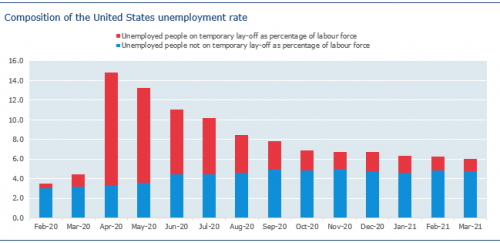Unemployment Rates, OECD - Updated: April 2021
Marginal fall in OECD unemployment rate in February 2021, to 6.7%, 1.4 percentage points above its pre-pandemic level
The OECD area unemployment rate declined in February 2021, to 6.7% (from 6.8% in January), remaining 1.4 percentage points above the level observed in February 2020, before the COVID-19 pandemic hit the labour market.

The measures put in place by national governments to reduce the spread of the Coronavirus (Covid-19) may have impacted on the ability to field surveys, and so, in turn, on the quality of statistics typically produced. In addition, because of differences in national practices used to determine whether individuals are unemployed when under confinement, international comparability has also been affected
In February 2021, the unemployment rate was stable in the euro area, at 8.3% (1.0 percentage point above its pre-pandemic level). Latvia, with an increase of 0.2 percentage point (to 8.7%) and Slovenia with a decrease of 0.2 percentage point (to 4.9%) represented the largest changes in this area, while little movement was observed in other countries.
In the United States, the unemployment rate fell marginally in February 2021 (to 6.2%, from 6.3% in January), along with a decline in the number of people on temporary lay-off, while in Canada it decreased by 1.2 percentage points, to 8.2%. More recent data show that in March, the unemployment rate declined further in the United States (by 0.2 percentage point, to 6.0%) and Canada (by 0.7 percentage point, to 7.5%). In February 2021, among other countries, the unemployment rate for Australia (down by 0.5 percentage point, to 5.8%) recorded one of the largest declines. By contrast, the unemployment rate increased by 0.5 percentage point in Israel (to 5.1%) and was stable in Japan (at 2.9%) and Mexico (at 4.5%).
The OECD youth unemployment rate (people aged 15 to 24) decreased to 13.7% in February 2021, from 14.0% in January.
More generally, it should be noted that unemployment statistics do not account for the full amount of labour market slack due to Covid-19, as some non-employed people may be classified as “out of the labour force”, because, due to the pandemic, they are either not able to actively look for a job or are not available to work.
Source: Organisation for Economic Co-operation and Development
- 479 reads
Human Rights
Fostering a More Humane World: The 28th Eurasian Economic Summi

Conscience, Hope, and Action: Keys to Global Peace and Sustainability

Ringing FOWPAL’s Peace Bell for the World:Nobel Peace Prize Laureates’ Visions and Actions

Protecting the World’s Cultural Diversity for a Sustainable Future

Puppet Show I International Friendship Day 2020

